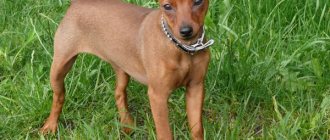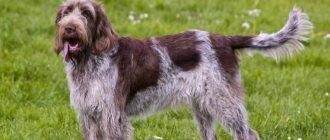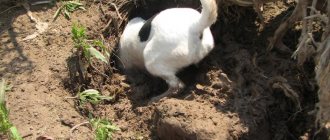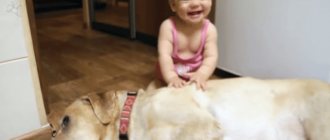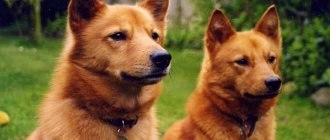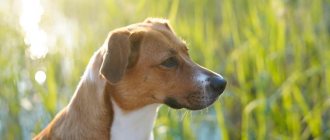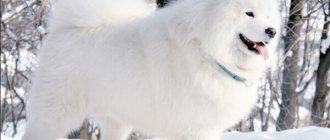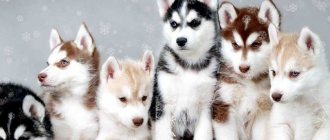It is believed that the dwarf Doberman (miniature pinscher) is an excellent compromise option for those who want to have a real “fighting” dog, but are limited by the modest conditions of a city apartment. This common belief is partly true, but you need to take into account all the nuances of buying such a puppy. Often on the Internet, the Miniature Pinscher describes the breed and receives not the most flattering reviews about its content. This is because future owners do not calculate the possible risks. But they exist, and this article is dedicated to the peculiarities of keeping these small but remote dogs.
Description and characteristics
The miniature pinscher looks like a small Doberman.
The breed belongs to the representatives of service dogs. The dog has a proportional build. The head is oblong, the muzzle is narrowed, the jaws are developed. The neck is slender without hanging folds, the back is straight, the chest is strong, the stomach is taut. The tail is medium in size, saber or sickle shaped. Limbs are straight and strong. The gait is confident and smooth. The coat is short, thick, smooth. The color can be black, brown, gray-blue, red.
The length at the withers reaches 25 cm, weight no more than 6 kg.
Take the Attention Test! Find 10 differences! (click right here!)
Find the answer Are you bothered by some problem or question? Enter “Breed” or “Name of the problem” into the form, press Enter and you will find out everything about the issue that interests you.
pros
Thoroughbred individuals have the following advantages:
- Small size;
- Strong immunity;
- Endurance;
- Sentry quality;
- Easy coat care;
- No unpleasant odor;
- Ability to learn;
- Devotion.
The dog is small in size and suitable for apartment living. With frequent walks, a small room will not cause inconvenience to the animal and the owner.
The breed has excellent health and suffers less often than others from hereditary diseases.
The individual is characterized by strength and endurance. Often used as a service dog. The dog is able to accompany its owner on long hikes.
He has keen hearing and senses tracks. The qualities are suitable for search and guard activities. The puppy exhibits a protective instinct, trying to protect the territory and the owner. The miniature pinscher is naturally suspicious and does not trust strangers.
It has no undercoat and sheds little. Grooming does not require much time.
Doesn't smell like dog. Smooth wool repels dirt. After a walk, just wipe the animal with a damp towel.
The little pinscher is easy to train. A trained pet will obey its owner, following all his commands. The dog may be trained to relieve itself in the litter box. This will prevent walking in bad weather.
The Miniature Pinscher will be devoted to all family members. He loves the owner's children and will be a reliable protector for children. Someone else's child can cause jealousy.
Watchdog and protective qualities of the dog, and its attitude towards children
The Miniature Pinscher is an impeccable watchdog with a clear voice. The dog has a brave and fearless heart. His affection for his owner is so great that the dog is ready to defend himself even if his life is in danger. When meeting with a larger opponent, the pinscher strives to find a high ground and attacks the enemy from there.
The dog is a very reliable and faithful companion for tourists and travelers, ready to follow its owner to the ends of the world. The dog can get along well both in the city and in rural areas.
The Miniature Pinscher, being an energetic dog, gets along well with children and takes part in games with them with pleasure. When this dog appears in the family, children should immediately be explained that during games they should not pick up the dog by the front paws or the scruff of the neck, since such handling can harm the dog’s health and damage the tendons. The best way to pick up a dog is to lift it, supporting it with your palm under its belly.
The history of the breed goes back about 300 years, and during this period, dogs of this breed, despite their small size, have more than once proven their devotion to their owner and shown their good attitude towards children.
Minuses
There are such negative qualities as:
- Excess activity;
- Cocky disposition;
- Loud barking;
- Excessive suspicion;
- Intolerance of loneliness;
- The need for long walks;
- Digging instinct;
- Desire for leadership.
The breed is restive and active. Excessive energy in a pet can tire you out. This dog is more suitable for strong young people who can cope with the animal's temperament.
The character is conflicting. A male dog will bully other dogs and get into a fight, even if the opponent is larger.
They love to bark loudly. This is how they warn the owner about their readiness to protect him. Frequent dog barking displeases neighbors.
Innate suspicion manifests itself even towards guests who come “in peace.” May behave aggressively.
Can't stand loneliness. Bored, he will whine and cause chaos in the house. The owner is forced to devote a lot of time and attention to the pet.
https://dog-care.ru/porody/reyting/tsvergpincher-otzyvy-vladeltsev.html
To release energy, the dog needs frequent long walks. Otherwise, he will create a mess and mark his home territory.
From our ancestors who caught rats we inherited the instinct to dig. In parks people are rushing to make potholes in flower beds, and they will dig holes on plots of land. The flaw is difficult to correct.
The individual is cunning and capricious. Only the reputation of the leader-master matters; he tries to dominate over the others. Training is mandatory; its absence leads to behavioral problems. Before you get a miniature pinscher, you need to be confident in your moral and physical strength.
Miniature Pinscher: maintenance, care, photo
Dogs with short hair are constantly cold, so their place in the house needs to be given special attention.
It should not be on a draft or cold floor. Doberman requires good and thick bedding, or even a special house. For winter walks, your pet must buy or sew warm clothes, otherwise the dog may get sick. The breed's paws begin to freeze already at -7C. Therefore, it is recommended to purchase boots for walking.
Pinschers do not feel well even in the heat. In such weather they are at risk of heatstroke. To avoid this, you should take drinking water with you for a walk, and in very hot weather you can even wet your pet.
Even if your pet is litter box trained, it needs to be walked every day. It is best to do this twice a day for at least 30 minutes. During a walk, the dog should move actively, since the breed is prone to obesity.
Smooth-haired dogs need to be brushed several times a week. They consider this procedure a sign of affection and love it very much. But bathing pinschers is not recommended, since the pet can easily catch a cold. You should only wash your dog when necessary.
The breed cannot be picked up by the scruff of the neck or front paws. Such actions can damage the tendons. Therefore, it is better to carry your pet under your belly. A dog with a small weight does not have time to sharpen its claws while moving, so they need to be trimmed on time.
What you need to know
Before starting to work on the character of his pet, the owner needs to find out what qualities a puppy must have in order to be called well-mannered and obedient. The processes of training and education have a close relationship. Training includes learning to unquestioningly carry out simple commands. You can start it immediately as soon as the puppy appears in the house (regardless of its age) and the equipment and necessary things have been purchased for it. Education involves the formation of a clear hierarchy in the family, an understanding of what the owner’s behavior should be towards the dog.
We cannot ignore everything that a well-mannered puppy and its owners should know:
- If owners want to solve difficulties associated with their pet’s behavior, they must learn the main rules of upbringing. Failure to comply with these principles becomes the main reason for their appearance.
- One of the most important skills for a pet is toilet training outside or in a certain place in the house. The puppy will not be able to deal with these issues on his own. He can acquire this skill only through training. You need to start developing good toilet habits as early as possible. And the more correct the chosen training tactics, the faster you will be able to achieve stable results.
- You need to train your pet from the moment it starts living in your home. At a minimum, he should learn and follow basic commands.
- Puppy owners can face many difficult situations. For example, if a baby fawns over strangers, they begin to fear that he will not be able to become a reliable protector. Or, perhaps, the puppy bites when trying to feed and during play. Other pets may pick up crap from the floor or flatly refuse to listen to you. If you pay attention to different aspects of education, you can solve such problems.
History of the origin of the breed
The homeland of the miniature pinscher breed is Germany, where the first miniature smooth-haired pinschers or so-called miniature Dobermans appeared almost three centuries ago.
This is interesting! There are no reliable sources indicating the origin of the miniature pinscher, but the very first mentions of dogs similar in appearance to the miniature pinscher date back to the mid-fifteenth century.
According to some versions, the ancestors of the breed were Scandinavian dogs that lived on the Baltic shores and near Swiss lakes. Most likely, the black and tan English terrier was brought to Germany from Great Britain.
It was on the basis of this dog that it was possible to develop a smaller variety of the breed, rich in different colors, including brown, chocolate, light red, blue, as well as shiny black with very pronounced tan marks. Dogs with a very original deer color in Germany were called “Re-pinscher”.
Miniature Pinschers are an old breed, and some external resemblance to Doberman Pinschers was acquired post facto . Initially, pinschers were housed near stables, where small dogs were used not only as guards, but also for catching various rodents.
However, over time, this breed gained increased attention and gradually turned into a very popular house pet. Starting from the second half of the nineteenth century, German breeders began targeted breeding work with the aim of breed improvement of the miniature pinscher.
The basis of the educational process
How correctly the puppy will be raised depends on the owner’s persistence, the amount of time spent and love for the pupil. There must also be strict control. Just because you love your pet does not mean that he cannot be punished for pampering or trying to eat something harmful from the floor or the ground. The best owner for any dog is a strong, demanding, but kind dad.
There are several important and effective secrets of proper upbringing:
- If the puppy deserves physical punishment, there is no need to make concessions. The type of punishment will have to be applied at the beginning of education. In the future, the dog will wean itself from doing bad things and will know that at the first request it needs to execute the “fu” command. You should not lose sight of the fact that until the age of 3 months, a pet cannot be raised using physical punishment. At a tender age, parenting methods should be extremely careful.
- The baby should receive as many positive emotions as possible from the owner. The pet takes negative emotions and punishment for granted if they are appropriate, and the owner does not forget to praise his pupil. It is worth encouraging the puppy, for example, when he correctly followed the command, went to the toilet in a special place. Many owners pet their dogs even without achievements. If you use this gesture of attention more often, the contact between the owner and the puppy becomes closer.
- If you took a puppy to become a friend, a protector, then you need to take into account that loyalty is the quality of those dogs that consider their owner a member of their pack. Then the dog is really ready to give his life so that you can be saved.
Overly cruel and demanding owners will not be able to raise a reliable protector. This does not mean that you can allow people to sit on your neck. The principle of the golden mean is to initially praise the kids as often as possible, and over time, praise and encouragement with treats for following commands will be needed much less often.
Health
The lifespan of Miniature Pinschers ranges from 13 to 16 years. There are isolated cases where babies lived for 20–25 years, but such indicators are rare and are justified by excellent genetics. Popular diseases of Miniature Pinschers are associated with both the size and the heredity of the breed. It should be noted that dogs have good immunity and good health, provided that they are provided with proper care. Diseases to be wary of are:
Infectious diseases - Miniature Pinscher puppies are susceptible to distemper, enteritis and rabies, so the importance of timely vaccination should not be forgotten.
Vision and eye problems typical of all small breeds - retinal atrophy, cataracts, glaucoma, corneal dystrophy, pannus, entropion/eversion of the eyelid.
Hormonal disorders, most often we are talking about diabetes mellitus, that is, the body’s inability to produce insulin in sufficient quantities. A dog suffering from this pathology can live a full life, provided it receives regular insulin injections.
Congenital dislocations. Fractures, sprains, dislocations as a result of injuries.
Aseptic necrosis of the femoral head or Legg-Calvé-Perthes disease is also considered a pathology of small breeds. The disease is accompanied by degenerative changes in bone tissue. Most often, puppies aged 6 to 12 months suffer from the disease. The consequences depend on timely diagnosis and treatment, from chronic lameness to loss of control of the limbs. The pathology is accompanied by acute pain.
Urolithiasis is considered a consequence of colds or poor diet. All small breeds require particularly strict control over the diet and the intake of salts and minerals into the body. The disease can be treated and prevented.
Will moderate severity offend a puppy?
It’s rare that someone manages to raise a dog (even if this happens, not with every pet), using only rewards. For example, these will be treats, praise. For the most part, dog owners are convinced that it is impossible to do without punishment.
If you pay attention to your puppy, play with him, spend a lot of time together, and don’t forget about appropriate praise, then he won’t even remember about strict educational measures. Dogs understand everything well, but it takes time to establish close contact.
Determining your role in the pack
Regardless of its age, the dog perceives the family of its owners as a pack that must have a leader. In her understanding, it is impossible for a pack to survive without a leader. Therefore, to ensure all members survive and achieve a better life, the pet strives to take the place of leader.
Natural instincts make a dog challenge you to see if you are strong enough to deserve to be the leader. The puppy first tries to find out his chances of leadership at approximately 4-6 months of age. For example, he may growl when wiping his paws after a walk or when his owners approach a bowl of food. Sometimes the dog may even “signalize” the bite. There is no need to be afraid of this behavior - this is done to find out who is in charge in the pack. Only a strong leader can ensure survival and protection.
Although the determination of leadership is a natural phenomenon for dogs, this does not mean that coexistence will turn into a struggle for dominance in the family. You just need to always get what you want from your pet. It is important to maintain self-confidence. Dogs do not like weak-willed individuals who do not have their own opinions.
What age should you choose a dog?
It is preferable to purchase a dog when it is still a puppy.
The optimal age for a puppy is 2-3 months. During this period, miniature pinschers show curiosity and become independent. Their psyche is already established, so moving will no longer be too stressful for them. Adopting an adult dog is always worse than adopting a puppy. After all, she is already attached to her former owner, her character is already fully formed. For an adult Pinscher, moving will be very stressful. Before buying an adult dog, get to know it in advance, study its character and habits. It is very good if she is trained. Find out if the animal gets along with other pets, if you have any. How to prepare for the arrival of a puppy? Before you bring the puppy into the house, you need to: Set up a sleeping place for the dog; Determine the place where you will feed her; Learn more about how to care for your puppy; Decide on a veterinary clinic where you will go to get preventive vaccinations and periodically check your pet’s health. You need to decide on the toilet in advance. You can teach your four-legged friend to ask to go outside, but for such small breeds, a home toilet is quite acceptable, the location of which should be determined in advance.
NEAPOLITAN MASTIF: BREED STANDARD (APPEARANCE) AND GENERAL CHARACTERISTICS OF THE BREED
HUNGARIAN VIZSA: DISEASES AND CONTENT
Dachshund: HISTORY OF THE BREED, CHARACTER AND DISEASES OF THIS BREED OF DOG
COLLIE: HISTORY OF ORIGIN AND CHARACTER
Simple conclusions for the owner
To raise a well-mannered and obedient puppy, you need:
- Engage with him in studying and executing commands.
- Set clear and understandable rules.
- Solve problems that arise during the education process.
- Insist on.
- Don't be afraid to use physical punishment.
- Remember that you can never have too many positive emotions and games.
- Show your dog confidence in his abilities.
- Believe that if you work and put in a lot of effort, success will come.
And the most important thing to always remember is not to worry about small failures or difficulties. After just a short period of time, you will be surprised by the positive changes in the character of your pupil. You just need to work while maintaining optimism and a good mood.
Announcements on NN.RU - Home
I am selling a D5200 camera and an AF-S DX NIKKOR 18–55mm VR lens, in excellent condition, no scuffs/chips, used. Price: 15,500 rub.
I have been repairing cell phones since 2007. I don't mind the prices. I don't meet deadlines. Contact us, you won’t regret it. Price: 500 rub.
REGROUVER MACHINE for cutting the tread of tires of cars and trucks. FREE REPAIR GUARANTEE FOR ELECTRONIC PART. Price: 14,000 rub.
Travel to any area of the city is free, we work even on holidays. We will repair any TV and provide a guarantee of up to 20 months. Fast and... Price: 500 rub.
Article on the topic: Cadillac ats owner reviews
What should a novice trainer remember?
To prevent training from turning into torture, you need to consider a few more points:
- Any workout can be made easier. To do this, you need to take your pet for a good walk in advance. A tired, running dog will be less distracted. This means the effect will be greater. According to experienced owners, active walking makes working with the animal several times easier.
- Each command is spoken only once. They cannot be duplicated. The dog quickly grasps, if he understands that the owner can repeat the same thing several times, then he will stop performing the technique the first time.
- There must be pauses between teams. When practicing, for example, “near”, “lie down”, “fetch”, you need to give the dog time to take a breath. 5-10 seconds will be enough. If you do not pause, the dog may simply become confused.
- It's important to change the sequence. During training, it is better to practice all techniques separately. If the dog gets used to doing everything in order, nothing good will come of it in the end. Unless he develops a reflex. That, for example, after “to me” you need to “sit.” The dog must master commands in any sequence.
- You cannot overload your student. Too intense training can harm your four-legged friend. We must always keep in mind that a dog is a living creature. She may have some pain. Or not being in the mood to study.
An already trained dog is able to perfectly carry out commands under any conditions. But we must keep in mind that your pet may get tired.
- Sometimes students, like ordinary schoolchildren, “run away from class.” They may be distracted by a nearby cat or other dog. This can be avoided if you are more careful about exposure. Train her on a long leash. This will allow you to catch up with the “mischievous person”, even if he runs fast. A leash with a carabiner for 3-5 meters is suitable. Often such a leash is just needed for endurance and training to pick up “goodies” from the floor.
- “Mass” training is not allowed. Only the dog's owner should act as a trainer. The dog must obey all family members. And pets must master the basic principles of raising an animal. But at the training itself there are only two people: the owner and his pupil. Otherwise, the dog will be constantly distracted.
- Sometimes during training it is worth pausing. It happens that the dog looks scared. He follows commands, but seems to doubt the correctness of his actions. The reason is usually that the owner was too strict and overdid the load. In such cases, you need to get the dog to fulfill the simplest command for him, and then generously praise him. More than usually. The dog, seeing that the owner approves of him, will begin to perform the exercises better. You can even play with the dog or take it for a walk.
- To develop the ideal execution of techniques, they need to be studied systematically, gradually. It is necessary to teach your pet to follow commands in any conditions. Start with perfect obedience in a calm place, gradually adding “stimulants”. They can be created artificially. For example, scattering treats. Or invite a friend to walk past your training place at a certain time. You can come up with “irritants” yourself or read reviews from experienced owners.
Miniature Pinscher - description of the breed (owner reviews about dog behavior)
Internet users in their statements often mention similar nuances of keeping miniature pinscher dogs. Analysis of popular opinions allowed us to identify key factors that will be extremely interesting to people who are considering whether to buy such a pet or not. We will cover all the pros and cons of the miniature pinscher breed in the format of popular questions from beginners and answers from experienced owners. Thanks to this collection of information, your decision to purchase a pet will be balanced and made with a full understanding of the situation.
Why should you choose a Pinscher?
Here and below, owner reviews about the miniature pinscher breed are given while preserving the authors' spelling (a partial change in direct speech is possible, as indicated by the sign <…>).
Elena
I wanted a small decorative dog so that it could go potty and would not require special training.
My husband wanted a serious dog, but, firstly, a large dog in an apartment was not an option, and then we lived in an apartment. After wandering around the Internet, it was decided to take Zverga, which satisfied both requirements: small and not decorative.
Karmecha
In my opinion, the ideal breed for keeping in an apartment and with small children, you just need to immediately explain to it what is possible and what is not, otherwise the pinscher will sit on your neck.
annaopalus2013
In fact, the “miniature pinscher” has a very cute appearance, shiny, hard fur. Well, he's just handsome, if you don't know about his character.
Mila
My husband was against mini dogs. I am only for them and no one else, and so they agreed on the miniature. After all, the advantage here is that the dog is small (they are also considered mini), but unlike minis, they are strong, dexterous, hardy, smart dogs and do not require special care; their coat is smooth and shiny and does not require cutting. They love children madly.
Dove
My pinscher will soon be 7 years old. To say briefly that this is an ideal dog is to say nothing. Very easy to train, loyal, excellent both as a guard and as a hunter. Walking with a Pinscher is a pleasure.
How high maintenance are miniature pinschers?
Alex.androvna
The miniature pinscher is the absolute opposite of the word “couch potato.” Lying on the couch with you and running out to pee for 15 minutes a day is just hell on earth for her. She requires at least 2 hours of time a day for education, care, training and walks.
Marina8331
The skin is always clean and does not shed. We never clean the ears - they are in perfect condition. In winter we don’t walk for long, they can use a diaper.
Just For Now
After each walk, the dog should be wiped with a damp cloth. A bath with shampoo once a month, or less often, we focus more on the appearance and smell.
Figundished
I chose a dog based on the principle that this breed is easy to care for: the short hair practically does not shed, it is unpretentious, rarely gets sick, it is compact, you can always take it with you - it really likes to ride in the car.
Will the miniature be toilet trained quickly?
Olya Lolche
The dog peed on a cloth, sometimes on the sofa. Then I quickly learned to pee in the tray. But he only poops outside!
ele76
He “miniature pinscher” did not want to endure his needs at all. He went to the toilet wherever he wanted, and then he could trample on it. In fact, now I remember, and it’s very creepy, how I endured all this.
Just For Now
Toilet training happens the same way as with other breeds: it’s long, it’s tedious, and you’ll have to wash the floors in your apartment until they shine. At first, we laid disposable absorbent diapers on Nora, and she even went to them when she needed to. Everything was wonderful until she started tearing them. Brutal. Into small pieces. And, of course, there is. I had to give up this wonderful hygiene product and arm myself with a bucket, a rag and bleach. And, of course, walk, walk and walk again. In a couple of months, the puppy will learn to use the toilet outside, but this does not mean that surprises will not await you at home.
Hope
This breed loves to train, just take some advanced courses from experienced breeders and everything will work out. While we were in quarantine due to vaccinations (we adopted him as a baby, at 1 month), we trained him to use a tray with a diaper.
What are some pet health problems?
Boris Yorsh
If you choose the right food, it will not shed. I shed a lot due to the fact that the food was not suitable, I fed Grandorf, it was not shedding, but an allergy, then the fur generally began to fall off and it came to bald patches.
Karmecha
The Pinschers are in good health; over the years we have periodically visited specialists and had tests done solely at my discretion, and not out of necessity.
Just For Now
Miniatures gain excess weight quite quickly.
Shakira25
Health cases:
- vaccinations once a year (against rabies, etc.)
- removal of baby teeth, around 10-11 months.
- epileptic seizures (Corvalol helps, in food at night, 5-6 drops)
- falls on his side and whines when his stomach is touched (Enterosgel helps, half an hour before meals, dilute 1 tsp of gel with 1 tsp of water, and use a syringe without a needle in the mouth. Repeat for 2-3 days. For the first days, feed with rice broth , and every two hours.)
- dry skin on the neck under the collar (wipe with Chlorhexidine)
- film on the eye and tears (drip Tobradex)
How does a miniature pinscher behave at home?
La-mu-r-r-r
Vandalism began from the very beginning, as soon as you left the house, and as many here wrote, “the wallpaper was stripped to the concrete,” sofas and shoes were chewed, clothes that were hanging there were torn off the hanger in the hallway and were also chewed (although all sorts of bones, toys for gnawing and a whole bunch of other dog things were immediately bought), they began to clean everything they could, close all the rooms, but the wallpaper in the hallway continued to suffer every time, we talked to the breeder and she advised us to buy an enclosure and close it there when leaving, we bought an enclosure.
Marina8331
We have two little pinchers, the same age. The eldest is very attached to the hostess, the youngest loves everyone, including our guests. They don’t bark at home, but if someone rings the doorbell, they respond immediately. At the dacha, always guarding the territory. Children are never bitten.
Karmecha
Not a single damaged item, except for his son’s sock, which he himself threw on the floor, and in the first corridor there are rows of expensive shoes in large quantities. To prevent the puppy from gnawing on anything, he needs a lot of toys and not to scatter things on the floor. When leaving home, he closed a huge cage, bought the biggest one specially, there is a bed, a toilet, and a bowl of water hung up, and there is still a decent amount left. places for the puppy to move; when we were at home, the cage was always open.
TestingLAB
From what the “dog” did in the first months: stole and instantly ate any food, and sometimes things; jumped on tables in the kitchen, opened cabinets, bags, drawers, ate things from there; took things out of the closet and peed on them, and sometimes on the sofa; ate her own and other people's poop; she destroyed several books, paintings, and potted plants, pulling them off the top shelves; she tore any paper; howled for several hours without stopping; took shampoos from the top closed drawer in the bathroom and drank them; I took out bags of sugar or flour and carried them throughout the apartment.
Is it difficult to train a dog?
Shakira25
Only the first year can be trained! We learned the commands “Sit”, “Lie down”, “Serve”, “Turl”, “Give me a paw”, “Crawl”, “Barrier”, “Place”. They were never able to teach “Bring it.” After each command, a tasty treat or “Well done.” Better yummy)))
Lyudmila
My miniature is very smart, obedient, picks up everything on the fly, follows all the commands, she’s simply golden!
Guest
Mine turns 5 months in a week. Male. Sometimes he shows character, but if he raises his voice a little and speaks strictly, he follows commands and listens. The main thing is not to overdo it, otherwise one time I raised my voice so much that he wet himself.
TestingLAB
My efforts and patience more than worked; every month the dog became less and less rowdy. Now she lies calmly in her place, doesn’t dare jump into places she shouldn’t, and takes food when she can. Only strict discipline, inflexibility and a daily routine made her an adequate pet.
What future owners need to take into account
Anyjey7
A good dog breed, but not for everyone. It is not suitable for those who are calm and like to stay at home. This breed is very active, runs everywhere and sticks its nose in.
Yulia Udovichenko
Despite the fact that this dog is a born hunter, it is very friendly and loyal to humans. If you immediately firmly and confidently identify yourself as its owner, then the dog will obey you unquestioningly. You should never give in to slack with her, otherwise she will certainly take the lead.
Natalya Sarycheva
For those who want a dog that will grow on its own, do not buy this breed, as it requires a lot of attention, patience, understanding, love and education.
It just so happens that the Pinscher received warning reviews regarding its selection: if you have not contacted dogs and doubt that you can raise a puppy correctly, do not look in the direction of mini-Dobermans. Even if their dimensions are modest, their temperament is worse than that of the largest dogs.
